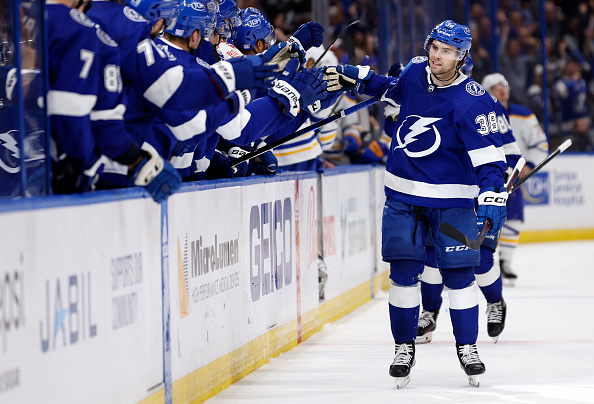The Tampa Bay Lightning went 7-4-1 through their first 12 games. Within those first 12 contests, it was a tale of two halves. In the first six games, the Lightning went 3-3-0. In the last six, they went 4-1-1. Clearly, a big difference. What’s going right? What hasn’t? Who has played well, and who has disappointed?
Tampa Bay Lightning Early Season Ups And Downs
The Surface Stats
On the surface of things, things seem pretty alright down south. In goals scored in all situations, the Lightning rank 14th (35 goals) in the league, while giving up the 14th least goals against (34). Nikita Kucherov has a team-high 16 points in 11 games, ranking tied for seventh in the league. Steven Stamkos is also tied for ninth in the league with seven goals thus far, with a scorching hot start to the year. Brandon Hagel has played up on the first line alongside Brayden Point and Kucherov and has gotten better and better with each passing game. Mikhail Sergachev is currently tied with Cale Makar for fourth amongst all defensemen in points (10).
The Lightning also rank 11th in the league for power play success rate (23.4%) and are tied for fifth league-wide in power play goals (11). Additionally, the penalty kill ranks eighth in the league in success rate (82.5%). Everything seems fine and dandy. So, what’s the issue?
Special Teams Is NOT What It Seems
The Lightning power play has scored a lot of goals, the numbers prove that. They’ve been successful, the numbers prove that. But how do they score their goals? Stamkos. From Kucherov or Victor Hedman. One-timer from the left circle. Goal horn blares, crowd goes wild. Rinse and repeat. That’s all fine and good, but the power play has been everything but. They are 15th in the league in shots for per 60 minutes (55.43), meaning they don’t shoot the puck all that often. That aspect hurts them. They pass the puck a ton, then turn the puck over and give up odd-man rushes. Don’t believe it? They have given up three goals against while on the power play, which is tied for most in the league. They’ve given up the third most scoring chances on the man-advantage as well, as well as the second-most high-danger chances against.
As for the penalty kill, they have the second-worst expected goals against in the league. They have given up a league-high 90 (!) scoring chances as well. Yet, of those 90, only five were converted to goals, thanks to their goaltending. But that’s not all. They have given up 31 high-danger chances, tied for sixth in the league. Yet, only two have hit the back of their net. Over an 82-game season, the Lightning are on track to allow about 671 scoring chances against on the penalty kill. Last season, they allowed 385, and the worst team allowed 489. As for high-danger chances, they’re on track to allow about 231 of them. Last season, they allowed 148, and the worst team gave up just 183. This is not a winning formula, at all.
Questions From Twitter/Facebook
“Best and worst forward / d?”
Based on tracked stats, the best forwards are easily Kucherov and Point. Hagel also deserves credit here too. Kucherov and Point are easily the best transitional forwards. Hagel gets to the dirty areas, though not as good as New Jersey Devils forward Ondrej Palat was for the Bolts last year. Other than them, the Lightning are mainly dump-and-chase. They also are the main offensive drivers. Surprisingly involved and efficient on defence. The worst forwards are probably Alex Killorn and Vladislav Namestnikov. They are both turnover machines in the defensive zone. Namestnikov has turned over a team-high 40% of his defensive zone touches, while Killorn turned over 28% of his.
As for defenders, Ian Cole has been surprisingly solid. He’s been the most well-rounded out of all defenders on the roster. Good against the rush, gets the puck out of the defensive zone, gets pucks in deep offensively, and has gotten a good amount of shots off from the point. Not the flashiest, not the most talented, but has been reliable. The worst defender is probably Cal Foote, which sucks to admit. He has been pretty brutal in his very limited attempts in the transitional game and isn’t really involved much in general.
“The Tampa Bay Lightning power play; are they generating shots from the point or are they getting high danger chances?”
The power play has generated high scoring chances, there’s no doubt about that. Stamkos has 22 shots on the man advantage, with the second-most (Kucherov) at 13. Stamkos had five high-danger chances and scored on all five of them. The problem is, they just aren’t really shooting enough. They pass themselves into submission, and that’s why they’ve given up so many chances the other way, as mentioned before.
“Same with even strength? What line is dominating possession and getting high quality chances?”
The most dominant line is easily the first, with Hagel, Point and Kucherov. The next best line offensively, at 5v5, is the third line: Cole Koepke, Namestnikov and Ross Colton. The problem with the third line is defensive zone play and transitional play. But, the first line has been the best when it comes to driving possession and offensive chances, unsurprisingly.
“What defensive pair has been the best at suppressing shots and limiting the opposition?”
Finally, this is an interesting thing to study. When it comes to defending the rush, Cernak is the most efficient, especially considering volume and match-ups. He has broken up over 50% of the rushes faced on his side of the ice. However, his partner is usually Hedman, and Hedman has struggled to defend the rush this season. He has allowed a team-high six scoring chances off the rush in games tracked. That said, only two defenders have defended the rush better than Cernak based on break-ups: Ian Cole (61.5%) and Philippe Myers (81.8%). Those two have been paired up before, so that pair is best at that aspect of the game. Sergachev and Nick Perbix have also been efficient in the defensive zone, but aren’t quite the best at defending the rush.
Some stats via Natural Stat Trick
Main Photo:






